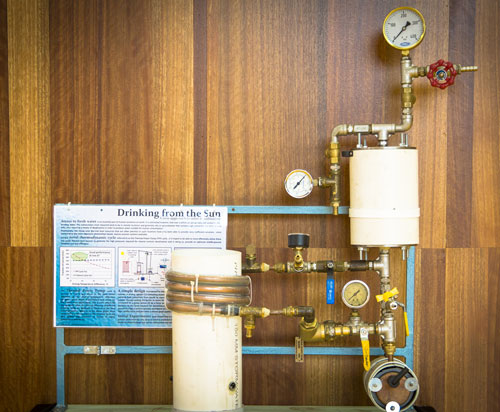| Feb 18, 2015 |
Clean thermal energy for clean fresh water
|
|
(Nanowerk News) Australian Parliamentary Secretary to the Minister for Industry and Science, Karen Andrews, announced the successful recipients of round eight of the fund at RMIT University today.
|
|
RMIT's Dr Abhijit Date was awarded the $AUD132,000 grant for his research into a sustainable and economical fresh water management system that could be used in coastal areas of India and salt-affected farming land in Australia.
|
 |
| Thermal Water Pump. (Image: RMIT University)
|
|
The system uses a special thermal water pump developed at RMIT and the University of Pune, India, which is driven by low-temperature thermal energy rather than grid electricity.
|
|
“There are many poor coastal communities in India where access to fresh water is an issue but they cannot afford to use standard power-hungry desalination and irrigation systems,” Dr Date said.
|
|
“The desal and irrigation system we are developing is both cheap to run and sustainable, producing no greenhouse emissions.
|
|
“Not only could this system help many coastal communities, it could also enable saline groundwater to be turned into fresh water and used for agricultural irrigation – helping farmers in Australia and across the world.”
|
|
The sustainable water management system runs on clean power sources – such as solar thermal, geothermal or waste heat – and generates both fresh water and water pumping power using thermal energy at temperatures below 100C.
|
|
Researchers have built a lab-scale prototype of the thermal water pump system, with early tests showing the system can produce 1000L of fresh water from 2000L of saline feed water with a salt concentration between 5000-15,000 grams per cubic metres.
|
|
The system works by boiling a refrigerant at constant temperature and using the pressurised refrigerant vapour to power a piston and pump water out. To suck water in, the vapour is cooled down, reducing the volume, pushing the piston in the opposite direction.
|
|
“The success of this project will provide a much needed alternative system that can be manufactured in Australia and provide opportunity for industry development, employment creation and export,” Dr Date said.
|
|
Dr Date is a Lecturer in the School of Aerospace, Mechanical and Manufacturing Engineering at RMIT.
|

